
Duracelle’s Battery, 1758
17th October 2021, 2 Comments
The French & Indian War, Rebels and Patriots, 28mm
This week, as Sean requested it, we played a French & Indian War game. As there were just three of us we opted for a scenario where there was a disparity in numbers. In the rules, one scenario involves an attack on an artillery battery, with the defenders having 18 points, and the assaulting troops 24. We scaled this up by half though, and had two British players with 18 points each. For this one, Sean and Mally played the attacking British, while I took command of the battery and its supporting French troops.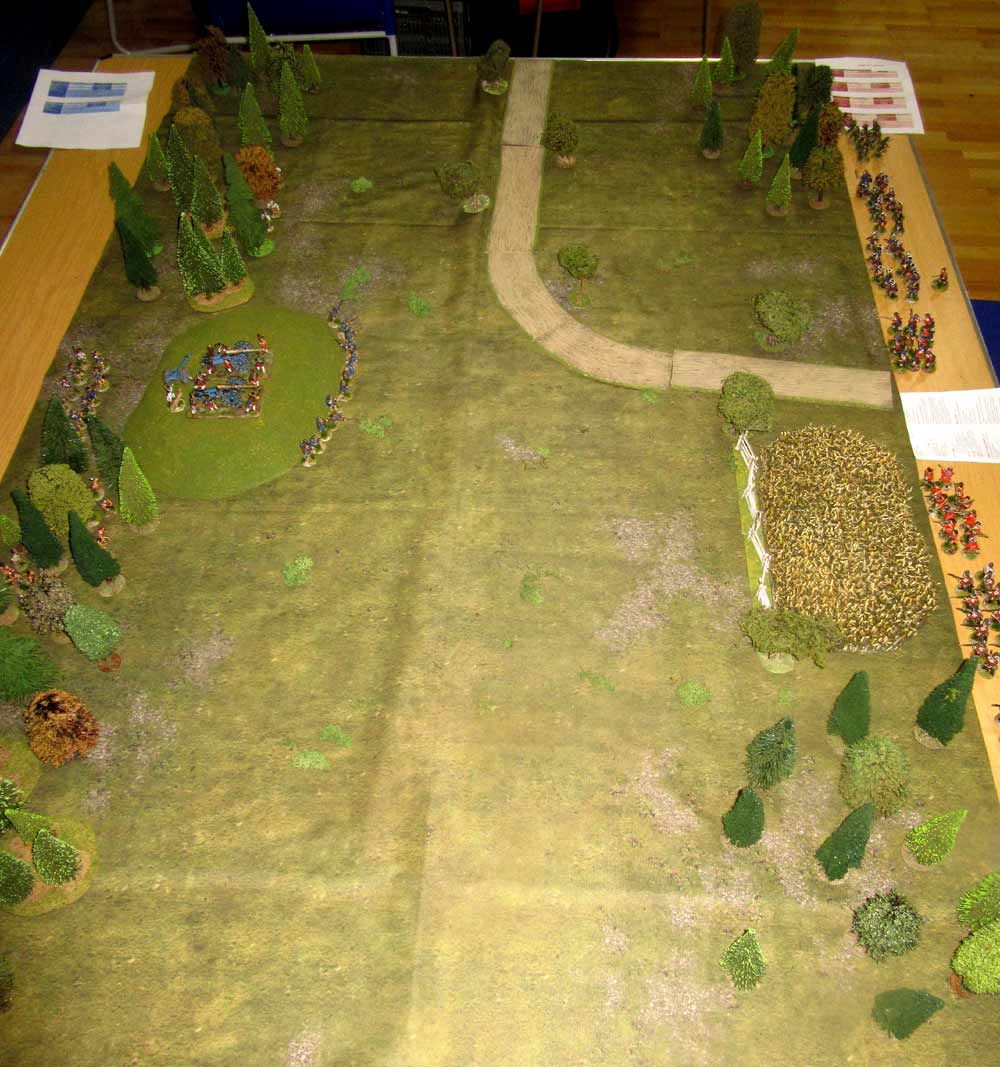 We played the game out on a 6×4 foot table, which essentially involved a small hill about a foot from the French table edge, and a large open field, fringed by trees. The idea was that Capitaine Duracelle’s Battery was busy bombarding the outer defences of Fort Carillon, a few hundred yards away, and the British commander General Abercromby ordered a force to sortie to take the battery.
We played the game out on a 6×4 foot table, which essentially involved a small hill about a foot from the French table edge, and a large open field, fringed by trees. The idea was that Capitaine Duracelle’s Battery was busy bombarding the outer defences of Fort Carillon, a few hundred yards away, and the British commander General Abercromby ordered a force to sortie to take the battery.  In our game, Mally’s left-hand column consisted of three 12-figure units – two of light infantry, and one of grenadiers (counting as shock troops). On his right, Sean commanded a more mixed back force of two 12-figure units of provincial line, one of Highland regulars, and a powerful Ranger unit. So, 84 figures. The French gun guards were a 12-unit of Companie Franche de la Marine, supported from the back of the hills and the adjacent forest by a unit of French line, a skirmish unit of 6 Canadian militia, and two Iroquois warbands, each of 18 figures. That came to 74 figures, including the two guns and eight gunners of the gun battery.
In our game, Mally’s left-hand column consisted of three 12-figure units – two of light infantry, and one of grenadiers (counting as shock troops). On his right, Sean commanded a more mixed back force of two 12-figure units of provincial line, one of Highland regulars, and a powerful Ranger unit. So, 84 figures. The French gun guards were a 12-unit of Companie Franche de la Marine, supported from the back of the hills and the adjacent forest by a unit of French line, a skirmish unit of 6 Canadian militia, and two Iroquois warbands, each of 18 figures. That came to 74 figures, including the two guns and eight gunners of the gun battery. 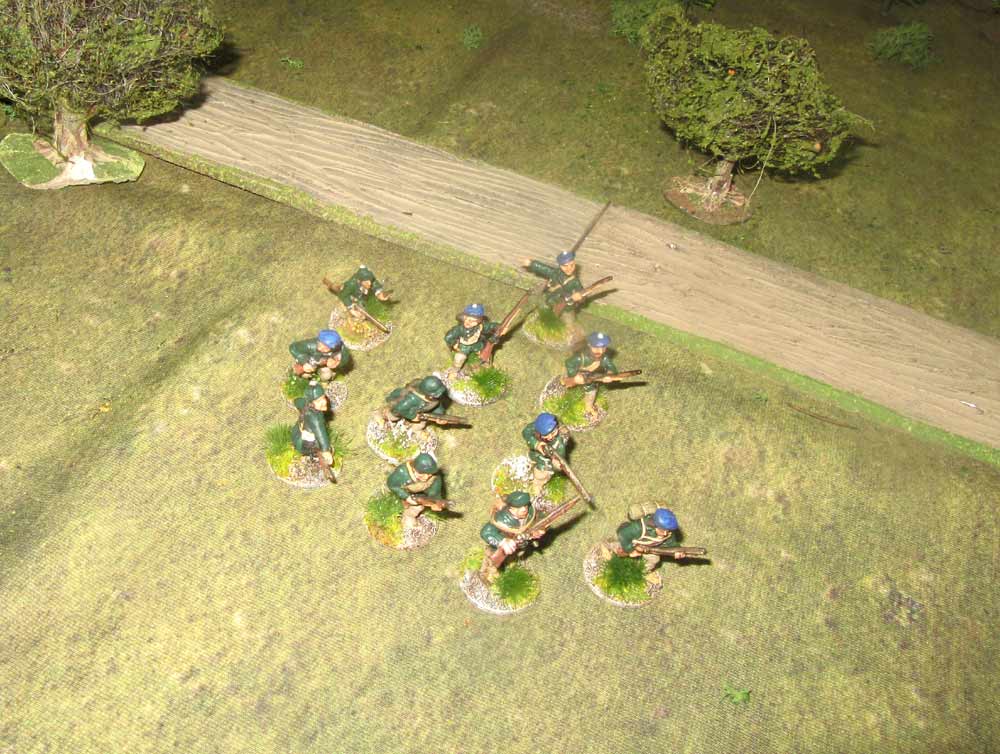 The British advanced from the start, although on the right Sean rolled several bad activation dice over the first few turns. So, he got off to a slow start. By contrast my guns both activated on every turn. At the start, I concentrated on the grenadier unit, firing at it with both guns. Meanwhile my marines, deployed around the base of the hill, fired at the advancing provincial militia.
The British advanced from the start, although on the right Sean rolled several bad activation dice over the first few turns. So, he got off to a slow start. By contrast my guns both activated on every turn. At the start, I concentrated on the grenadier unit, firing at it with both guns. Meanwhile my marines, deployed around the base of the hill, fired at the advancing provincial militia. 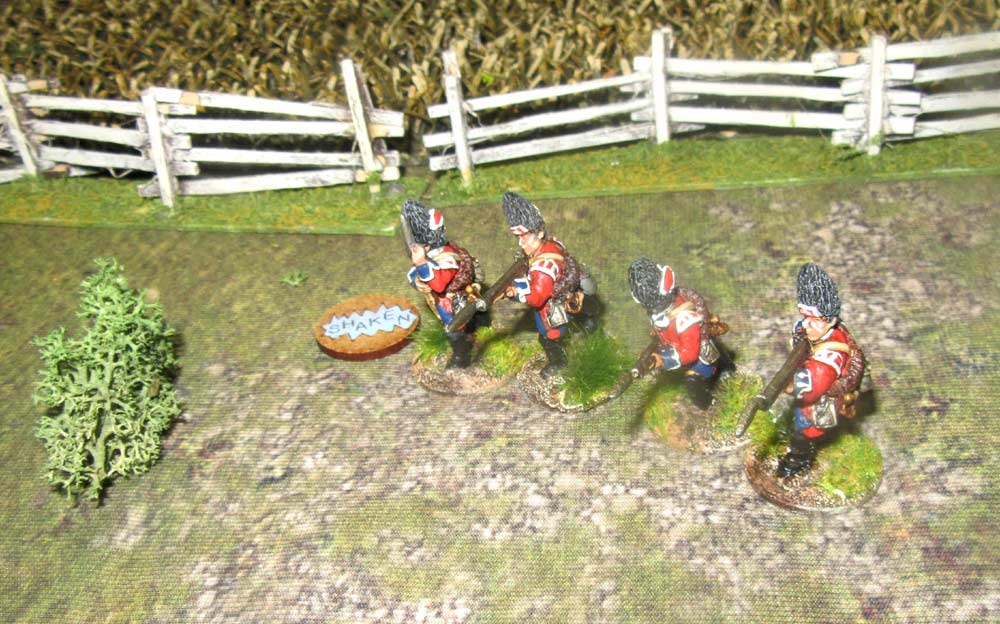 Gradually, the grenadiers got whittled away. When the unit fell back I switched the guns to a light infantry unit of Mally’s and caused two casualties. Amazingly, the resulting morale test was so bad -Mally rolled a “2” on 2D6 – that the unit broke and ran from the field. Actually, that was typical for this game – between them the two guns of Duracelle’s battery were killing two or three figures a turn.
Gradually, the grenadiers got whittled away. When the unit fell back I switched the guns to a light infantry unit of Mally’s and caused two casualties. Amazingly, the resulting morale test was so bad -Mally rolled a “2” on 2D6 – that the unit broke and ran from the field. Actually, that was typical for this game – between them the two guns of Duracelle’s battery were killing two or three figures a turn. To counter them, the British needed to get within musket range. The closest unit was Mally’s remaining light infantry unit – a mix of Rangers and Light Company troops. They did well, and even caused a casualty on on of Duracelle’s gun crews. It wasn’t enough though, as the French responded by deploying the regular unit of La Reine regiment, in close order, who fired volleys at them.
To counter them, the British needed to get within musket range. The closest unit was Mally’s remaining light infantry unit – a mix of Rangers and Light Company troops. They did well, and even caused a casualty on on of Duracelle’s gun crews. It wasn’t enough though, as the French responded by deploying the regular unit of La Reine regiment, in close order, who fired volleys at them.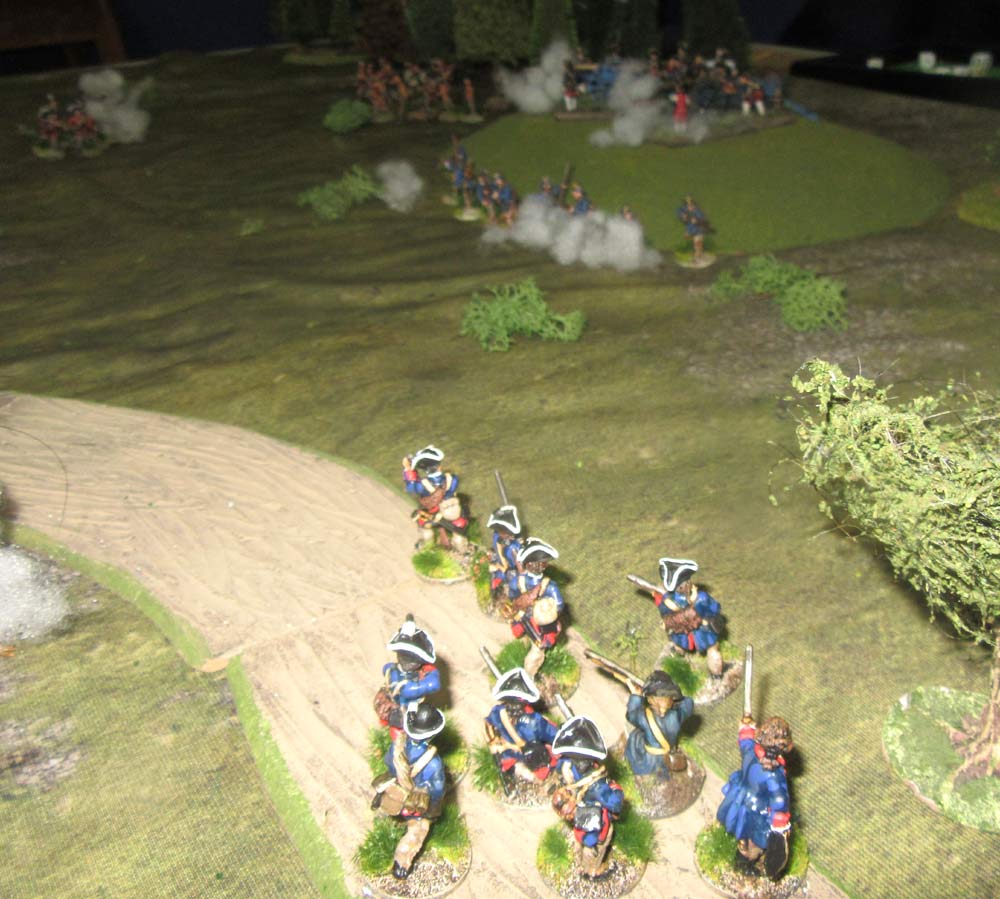 Over on the British right, Sean’s column had finally got within range, with the two blue-coated provincial units of the Massachusetts Regiment in the lead. Behind them was the unit of highlanders, while the Rangers were swinging wide, hoping to tempt the defenders to the left of the French battery out in the open. Actually, over on that side I had a wimpy unit of Canadian militia skirmishers, who never hit anyone all game, and a large unit of Indians, who stayed in the woods, ready to strike if the battery was threatened.
Over on the British right, Sean’s column had finally got within range, with the two blue-coated provincial units of the Massachusetts Regiment in the lead. Behind them was the unit of highlanders, while the Rangers were swinging wide, hoping to tempt the defenders to the left of the French battery out in the open. Actually, over on that side I had a wimpy unit of Canadian militia skirmishers, who never hit anyone all game, and a large unit of Indians, who stayed in the woods, ready to strike if the battery was threatened. In front of the guns the thin line of French marines were taking casualties, but giving as good as they got. Their real break though, came when one of the guns turned round to fire at the Massachusetts troops, to ease the pressure on them. They fell back, exposing the Highlanders, who then became the new target for the French left-hand gun.
In front of the guns the thin line of French marines were taking casualties, but giving as good as they got. Their real break though, came when one of the guns turned round to fire at the Massachusetts troops, to ease the pressure on them. They fell back, exposing the Highlanders, who then became the new target for the French left-hand gun. Over on the French right Mally’s light infantry unit had become disordered due to its mounting casualties. Thats when the other unit of Iroquois- a large warband – moved out of the woods, to get within chage range. The British defensive musket fire was poor, only killing one Indian, and after the La Reine troops had fired, the warband charged home. The result of course, was inevitable, and the already battered light infantry unit were chopped to pieces. With just four grenadiers left on the table, Mally was out of the game.
Over on the French right Mally’s light infantry unit had become disordered due to its mounting casualties. Thats when the other unit of Iroquois- a large warband – moved out of the woods, to get within chage range. The British defensive musket fire was poor, only killing one Indian, and after the La Reine troops had fired, the warband charged home. The result of course, was inevitable, and the already battered light infantry unit were chopped to pieces. With just four grenadiers left on the table, Mally was out of the game. That left Sean, with his Highlanders, two now battered provincial units, and the Rangers. All had taken casualties – especially the Massachusetts troops, and the highlanders were now being pounded by both French guns. Even the second Iroquois warband joined in, sniping at the Rangers from the woods. More failed morale tests followed, which in turn led to the British units falling back.
That left Sean, with his Highlanders, two now battered provincial units, and the Rangers. All had taken casualties – especially the Massachusetts troops, and the highlanders were now being pounded by both French guns. Even the second Iroquois warband joined in, sniping at the Rangers from the woods. More failed morale tests followed, which in turn led to the British units falling back.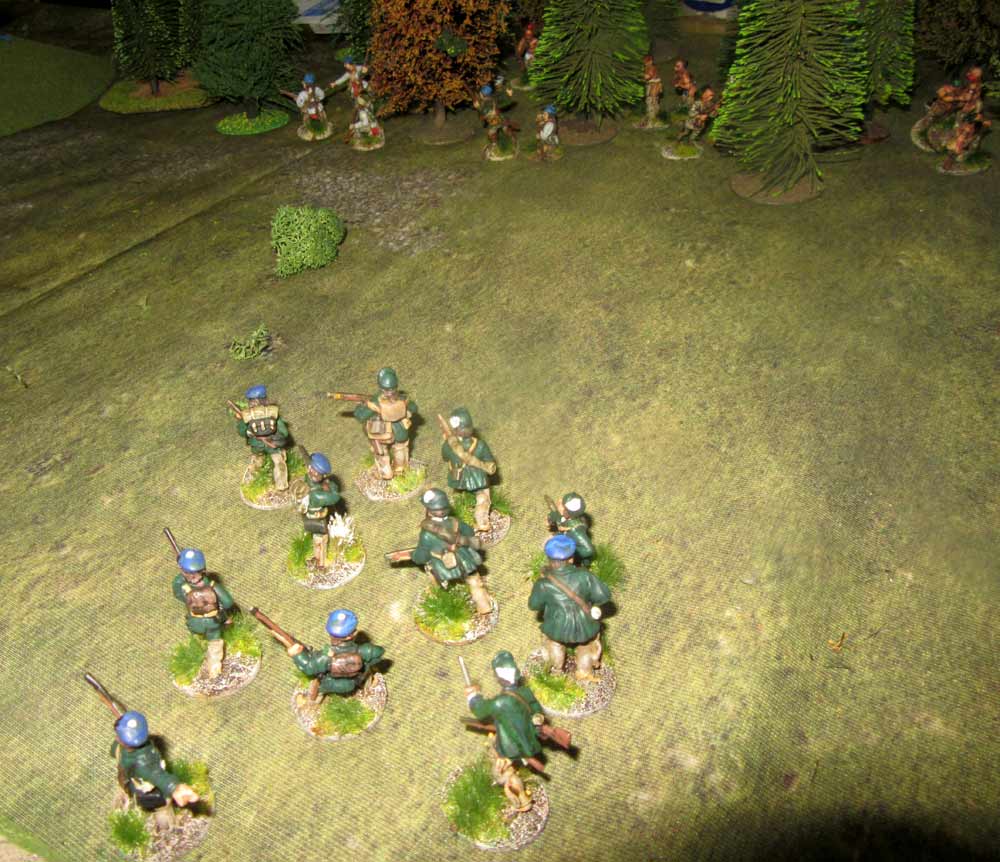 In the end, Sean and Mally conceded the game. It was clear Sean wasn’t going to get through to the battery, so he sensibly withdrew. With hindsight, the British could have raced forward with their light troops, who counted open ground as cover. Then, they could fire on the guns while the other units – the highlanders, grenadiers and provincial troops advanced behind them. Still, it was a valiant effort, and one of those nice wargames where both sides had a tactical problem to deal with – crossing open ground and scanty defenders – and had to come up with a plan to deal with it.
In the end, Sean and Mally conceded the game. It was clear Sean wasn’t going to get through to the battery, so he sensibly withdrew. With hindsight, the British could have raced forward with their light troops, who counted open ground as cover. Then, they could fire on the guns while the other units – the highlanders, grenadiers and provincial troops advanced behind them. Still, it was a valiant effort, and one of those nice wargames where both sides had a tactical problem to deal with – crossing open ground and scanty defenders – and had to come up with a plan to deal with it.


Ah, Capitaine Duracelle; exquisite pun. One might almost say this was a game of Carry On (‘Carillon’) capture that battery, which the British contingent was not Ever Ready to do. Shame there were no ‘Volt’-igeurs on the French side. 🙂
You can carry a pun too far, Martyn! Voltigeurs forsooth…!